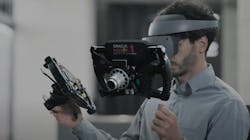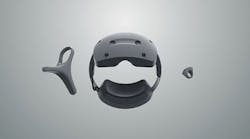Siemens and Sony Partner on Metaverse Vision
The industrial metaverse is an idea for which the basic building blocks are now being implemented across industry as part of a general digital transformation. A key technology component of the industrial metaverse is, of course, the cloud, which is already being used to access systems and data from any device at any time and enable interaction with co- workers in real time regardless of location. Coupling the cloud with artificial intelligence (AI) gives the industrial metaverse the ability to access historical data, test concepts and forecast new outcomes.
But much of the vision around any concept using the term metaverse tends to focus on the use of virtual reality (VR) headsets to immerse the user into a simulation of a real world setting they can interact with via the VR tech. And that’s where the industrial metaverse vision and reality tend to diverge—at least for now.
Though immersive VR has been used for industrial training for years now, many of the metaverse concepts proposed by automation technology suppliers are not always connected to an immersive VR concept. Instead, most focus on the metaverse as an always- on world connecting factories, machines, data and people. The immersive aspects are always a potential, but not a requirement of most industrial metaverse technologies, as regular use of the headsets still revolves around user comfortability with the headsets for extended periods of time.
Siemens and Sony, however, appear to be betting on immersive VR. The two companies recently announced a partnership to introduce new technology for immersive engineering that combines a Sony head-mounted display with Siemens’ Xcelerator design software.
The end product will be called the Siemens’ NX Immersive Designer, which combines the Siemens Xcelerator portfolio of software with Sony’s new spatial content creation system, featuring the XR head-mounted display with 4K OLED microdisplays and controllers for interaction with 3D objects. The headset features the Snapdragon XR2+ Gen 2 Platform, the latest XR processor by Qualcomm Technologies.
Though Sony plans to collaborate with developers of a variety of 3D production software, at launch, Sony is exclusively partnering with Siemens on this Xcelerator-related project.
The Siemens’ NX Immersive Designer is expected to be available in late 2024.
“We envision the industrial metaverse as a virtual world that is nearly indistinguishable from reality, enabling people—along with AI—to collaborate in real time to address real- world challenges,” said Siemens CEO Roland Busch during the announcement of this partnership at CES 2024. “This will empower customers to accelerate innovation, enhance sustainability and adopt new technologies faster and at scale, leading to a profound transformation of entire industries and our everyday lives.”


